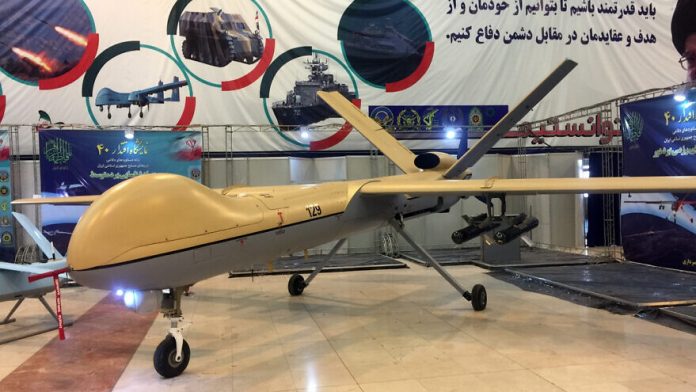With Tehran viewing itself as a regional power in possession of advanced technology, coupled with a commitment to “self-reliance,” its military industries have produced a sprawling industry of unmanned aerial vehicle mass-production lines.
The Israel Defense Forces is dealing with a growing “epidemic” of Iranian-made unmanned aerial vehicles, senior Israeli military officials cautioned on Monday.
The message came a day after the IDF revealed that in March 2021, Israeli Air Force F-35i fighter jets conducted their first interception of other aircraft, shooting down two Iranian-made UAVs as they approached Israeli airspace.
Those UAVs were identified as Shahad 197-type Iranian systems, which have a flight range of some 2,000 kilometers (1,240 miles) and a flight time of 20 hours.
One Iranian UAV was approaching Israeli airspace from the east and the other from the south. At least one of the UAVs had handguns on-board, representing an attempt to breach Israeli airspace and drop off firearms to Hamas in Gaza and likely to Hamas or Palestinian Islamic Jihad in the West Bank, according to the officials.
“This incident joins the growing list of Iran’s UAV attacks against Israel,” the IDF said in a statement on Sunday. In February 2018, an Iranian UAV launched from Syria was downed by an IAF Apache helicopter in the Beit She’an Valley area, which carried explosive material for delivery to terrorist elements in the West Bank.
In May 2021, Iran launched a UAV from Iraq at Israel, which was also intercepted in the Beit She’an Valley area.
In the March 2021 incident in which F-35s were scrambled in order to react, the UAVs were tracked by ground-control units in cooperation with intelligence, planning officials and the operational control headquarters of the Israeli Air Force, according to the IDF. “The UAVs were intercepted at the optimal operational point,” it stated.
“Iran is acting to proliferate weapons to its proxies and destabilize the region,” an IDF source stated. Referring to the proliferation of UAVs, the source said, “This has become a pandemic in the Middle East.”
With Iran viewing itself as a regional power in possession of advanced technology, and its commitment to “self-reliance,” Iranian military industries have produced a sprawling industry of UAV mass-production lines, according to IDF assessments.
Still, it has also run into a layer of constraints, the source said, describing UAVs as “not being a weapon of choice. The IRGC [Islamic Revolutionary Guard Corps] commander would prefer to have additional tools in his toolkit.”
Iran is also a “superpower of reverse engineering,” said the source, adding that following Iran’s interception of the American stealth RQ-170 drone in 2011, “it was only a matter of time until they reverse engineer and mass manufacture” a drone that was based on such a design.
“They are not going for the best but for good enough, and for a lot at a relatively cheap price,” said the source.
The Iranian UAV project is led by the IRGC’s Air and Space Force, while others like the Quds Force are also involved.
‘We are adapting every day; we are ready 24/7’
The IDF is responding by building up its early-warning and defense capabilities, said the source, stressing that Iranian UAVs are not an Israeli issue, but rather a region-wide issue, with moderate Sunni states targeted by such systems nearly every week.
The low-flying Iranian UAVs are designed to challenge radar-detection capabilities, though Israel has been able to detect every Iranian UAV launched in its direction.
Interception options include the use of fighter jets, helicopters and air-defense systems like Iron Dome.
“We are using all of our capabilities in defending Israel against this threat,” said the source. “We are adapting every day, according to intelligence and to commanders’ orders. We are ready 24/7, but this mission [of taking on UAVs] is a very different kind.”
The Shi’ite crescent stretching from Iran through to Iraq, Syria and Lebanon sees an extensive array of Iranian forces, proxies and surrogates all armed with the same equipment, the IDF officials said.
Asked why the March 2021 UAV incident saw the systems only carry handgun payloads, the source assessed that the attempt represented a probe by the Iranians to uncover Israeli vulnerabilities.
It’s not possible to know the exact target of UAVs—meaning that the goal of shooting them down using any means at the IDF’s disposal is critical, he said.
“The air forces’ No. 1 mission is to protect Israeli skies,” assured the source. “We are trying to defeat all threats, including drones.”
(JNS).






